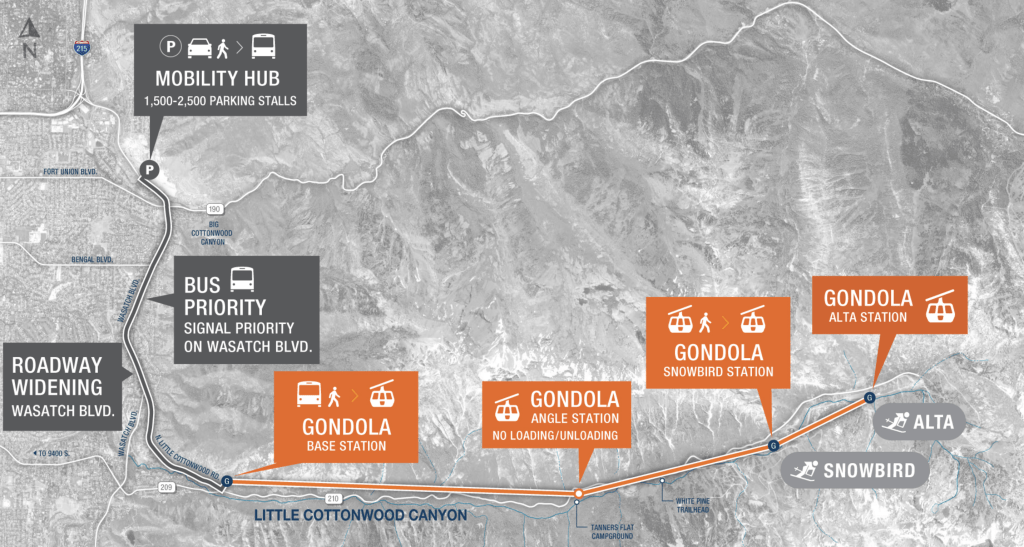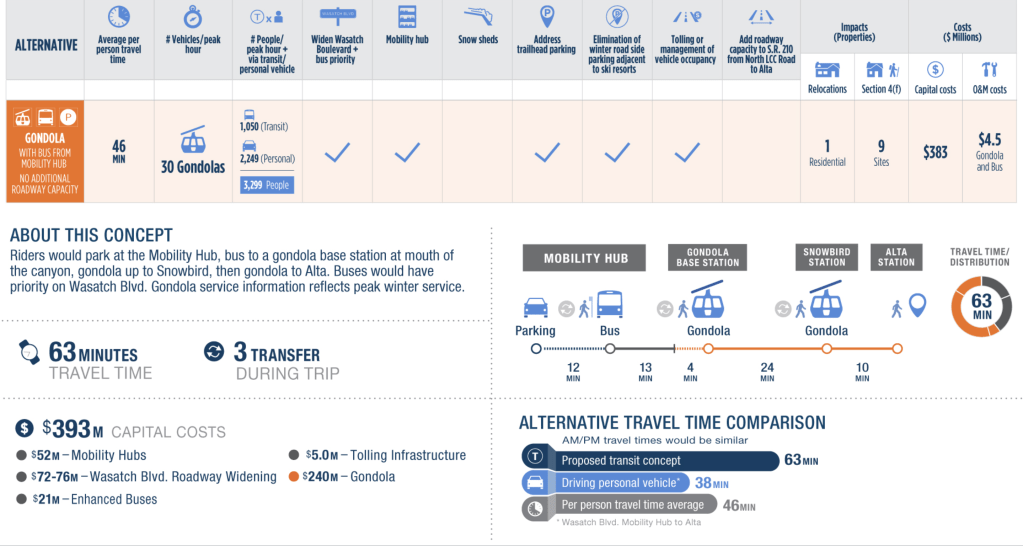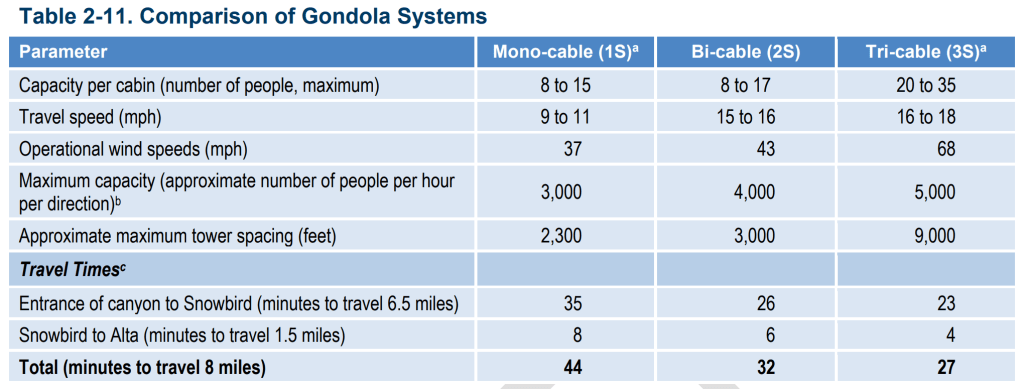Between crush loads of cars, large avalanches and frequent collisions, Utah State Route 210 can be a nightmare in winter. The 13.5 mile road connects the Salt Lake Valley to Little Cottonwood Canyon’s legendary Alta and Snowbird resorts. Utah’s Department of Transportation is currently studying ways to improve mobility in and out of the canyon with a focus on peak winter demand. Starting with 105 possibilities, the DOT last week narrowed its focus to three options: enhanced bus service, bus service combined with road widening and a hybrid bus/gondola option.
Stretching more than eight miles, the gondola would be among the longest in the world with more stations than any 3S system built to date. A tricable design was chosen for its ideal balance of speed, capacity and tower spacing. The lift would begin at the bottom of LCC, pass through an angle station at Tanners Flat and arrive at Snowbird 24 minutes later. Another 10 minute hop would link the eastern terminus at Alta Ski Area. The premise of the gondola is not to replace the road but rather divert a portion of trips to the air. This would be the second lowest capacity 3S ever built with thirty 30 passenger cabins arriving at stations every two minutes. A modest capacity would help manage costs and allow for towers spaced thousands of feet apart.

The Little Cottonwood Canyon gondola could operate in winds up to 68 miles per hour and strategically placed towers could keep it running when snow slides and crashes close the road. Guests and employees would enjoy an aerial journey through the canyon unlike anything in the United States. The system would cost $393 million, $77 million less than road widening but $110 million more than an enhanced bus solution. The gondola itself would run $240 million while the other $153 million is associated infrastructure such as parking and tolling. The aerial option would cost the least to operate, just $4.5 million per year versus $6.2-9 million annually for the bus options.
The gondola has some disadvantages. Due to the required location of the bottom station, riders would still have to take a 13 minute bus ride from an offsite parking hub before transferring. Buses would offer a one seat, climate controlled ride. With a dedicated transit lane, that trip would average 37 minutes, about 9 minutes faster than the gondola option. With no new roadway capacity, the bus ride would be about the same as the bus plus gondola. Personal cars would still be the fastest option when traffic is moving.
Buses have proven effective in resort towns like the one I live and work in. Nearly 60 percent of winter guests and employees arrive at Jackson Hole Mountain Resort via bus. Offsite parking is free and plentiful while onsite parking is limited and expensive. In the Teton Village example, more than 100 daily trips are offered between the town of Jackson, offsite parking and ski resort by bus. Frequent, all day service has allowed Wyoming 390 to remain two lanes and relatively free of traffic despite a 50 percent increase in skier visits the last two decades. Buses are more adjustable to demand than gondolas, particularly during off peak times.
Little Cottonwood Canyon presents unique challenges because traditional transit does no good when the road is impassable due to winter conditions and avalanches. A gondola offers an opportunity for a completely separate mode in and out of the canyon. It would be a unique and attractive alternative to driving a car.
UDOT will spend the next year developing an environmental impact statement and preferred alternative with a final decision expected by the end of 2021. You can learn more about the process and weigh in at https://littlecottonwoodeis.udot.utah.gov/.





I am glad to see that the gondola idea made it passed the initial cut. When UDOT first released the proposal for a possible gondola it seemed designed to discourage the option. This still can be seen in this proposal as well. It fails to focus on the advantages of a gondola over busses when it comes to things like avalanches. LCC closes whenever it snows and can cause massive delays to resort openings. On almost any weekend gondolas would almost certainly be faster than even dedicated bus lanes. Traffic in the canyon frequently takes well over an hour to get through. The fact is that all of these proposals realistically need to be paired with either paid for parking or a toll road to work(similarly to your Teton village example). I am glad to finally see something being done about the nightmare that that road is, but I often feel that UDOT and the Utah legislator is too focused on “How can we make driving better” and not “How can we make transportation better”.
LikeLiked by 1 person
I feel like part of the problem is that UDOT itself is in charge of solving the project. Part of why START works so well in Jackson Hole is because the Town of Jackson owns the service while the state and other larger government agencies only provide funding if needed. Jackson understands the local area better than any larger agency, so they are better equipped to provide adequate transportation solutions. Salt Lake County and the two LCC resorts better understand the problem here and should be the ones putting forth solutions, with UDOT only serving as a financier.
LikeLike
I think the best option would be an underground subway system and run it all the way to Brighton. Elon Musk’s company seems to be the cheaper at around $10,000,000 per mile. https://www.boringcompany.com/
LikeLike
It is not designed for this altitude differences. Rail connection would be the best, but I don’t see an underground system as the solution.
LikeLike
They included a train as an option in the previous phase of the study; presumably that option didn’t make the cut because of the cost… trains, for all their advantages (speed & capacity), are just a lot more expensive to build than gondolas.
LikeLike
Personally – I would love to see a S3 gondola system to access Snowbird and Alta. Some of them seat 24 people now.
Europe has all kinds of examples of S3 systems connecting a valley village to high altitude slopes (Ischgl, Mayrhofen, Saas Fee) …. you have the train at Zermatt….. and a normal gondola at Meribel from Moutiers …. there are others with trams and normal gondola systems.
I don’t think road widening will solve too much.
LikeLike
I rode the brand new Leitner Kleine Matterhorn this season and it’s an incredibly impressive system. I’d love to see a Leitner 3S for LCC access.
Parts of the bus plans sound good on paper but even if there are dedicated lanes, once there’s a good storm cars will be sliding all over and getting in the way of the buses.
I think one thing that needs to happen no matter the option chosen is actually strictly enforcing the chain and snow tire law. So many days the issues are caused by the people that think “I can drive good in the snow so it doesn’t matter for” and they’re driving up with AWD and all seasons or worse and sliding all over the place ruining it for everyone. Or the ones that you know are rental cars and aren’t equipped. Meanwhile I took the time to put my chains on my RWD sedan with snow tires because that’s the law even though I’d be fine going up without the chains. It’s so infuriating.
LikeLike
Why not run it past Alta and into Big Cottonwood canyon as well? For a few tens of millions dollars more you can help traffic in Big Cottonwood canyon too.
LikeLiked by 1 person
Alta owns the land that would be necessary for a gondola between the canyons and they have plans to one day build a ski lift connection (in conjunction with Solitude). This would be just as positive for skiers, as people could drive up one canyon, park, and ski in the other. Back before the final proposals were announced, Alta did say they would back a plan to run a train tunnel under their land to BCC if a rail proposal up LCC was chosen.
LikeLike
Thanks for suggesting that we destroy what little is left of the backcountry in upper LCC and BCC. There’s more than just winter resort users who recreate in these canyons.
LikeLike
Why not put a parking facility at the gondola base station rather than force people to take a bus shuttle to it?
LikeLike
It looks like the lower station is at the LCC parknride and it’s a tiny space
LikeLike
There is a lack of space for a large mobility hub at the base of LCC. BCC’s base has a large open mining site and plenty of flat, open land. They probably could have the proposed downhill terminal be another turn station and route the gondola over to the mobility hub, but that would be a lot more money and definitely mess with sightlines due to the need to traverse mountainous terrain.
LikeLike
I love that it’s being considered, and I hate to be the bad guy, but I don’t think it makes a ton of sense. Even if other systems are offered, and the current bus system is free for passholders, driving remains the easiest option. Until that changes, I don’t see anything major changing. Which means exactly what people don’t want to hear.
LikeLike
I have always wondered if the town of Alta could/should go car-free like Zermatt (Snowbird’s sister resort) in Switzerland in tandem with a gondola or train to the top of the canyon, as I agree that people will continue to predominantly drive as long as that is an option.
LikeLike
I agree- I think they’d have to eliminate free parking at the resorts to get a significant number of people onto the gondola.
As for going car-free, it seems like they’d need a bigger gondola if they were going to close the road entirely. 1,050 pph isn’t enough to get everyone up the canyon in the morning… that’s less capacity than a double chair.
LikeLiked by 1 person
Im in with the 3S gondola, However I want to know how the hell they are gonna construct big 3S towers in a steep canyon like little cottonwood. My guess is dynamite.
LikeLike
Explosives (whichever the actual energetic chemical compound is that is used) are relatively common in construction, especially the more spicy locales such as this. They can be applied in an incredibly precise manner. Far more efficient than them huge machines
LikeLiked by 1 person
I hope they go through with this. It will be epic not needing to drive up the canyon. Hopefully savethecanyons won’t throw a fit about it.
LikeLike
I’m guessing they will probably throw a huge fit about it and do anything they can to stop it. I’m guessing it will still go through though.
LikeLike
I mean if they do what Doppelmayr did with their 3S in Mayrhofner Bergbahnen where they have a curved saddle to facilitate a turn, they probably cut a few million off the cost (no angled station). Would the turn be too large to faciliate a curve saddle?
LikeLike
Interesting:
1. Are American Europeans ? No, we basically despise public transportation, and associated lack of privacy and convenience, let alone CV-19.
2. So, what does a “Day in Life of a Skier” look like in the gondola scenario ? Do I put my boots on before the bus ride ? or do I wait until the gondola ride ? or at the top ? If at the top, where do i put my stuff ? Lockers ? If I have a family, what does this look like ?
3. How do Gondolas work in the age of social distancing ? 30 packed side by side in a gondola ?
4. Are towers reaching into the sky less of an eye-sore than augmenting an existing road ?
5. What is the target audience ? Lift prices at the resorts are pricing out younger demographic, those who may be inclined to take public transportation….
LikeLiked by 1 person
Will you still be able to go up on the road in the summer?
LikeLike
I’m also curious about the summertime plan. I don’t ski anymore, but I do occasionally snowshoe in the winter and hike in the summer. I also ride my bike up the canyon at least twice each summer. How will the gondola plan affect these activities?
LikeLike
The gondola scenario sounds like a good transportation augmentation option during busy times – I get it. I started skiing at the Bird in ’91 and the traffic has gotten worse by orders of magnitude in the last several years (epic & Icon passes?). Hopefully the drive option will be open if the traffic is light during the week & will be restricted on heavy days – maybe make the gondola ride a requirement during snow days, holidays & weekends when the road gets plugged. A key issue would be communication signs on approach roads to the resort informing the public of transportation status (open to drive, restricted to bus/gondola etc.) How will the cost be passed on to the consumer? A pay per use fee? Season pass holders? Ticket prices? Huge parking fees at the resort?
LikeLike
14000 skiiers per day. A 1000 person per-hour gondola will definitely get them all there.
LikeLike
Says on the plan it’d move 3-4k per hour unless I’m missing something
LikeLike